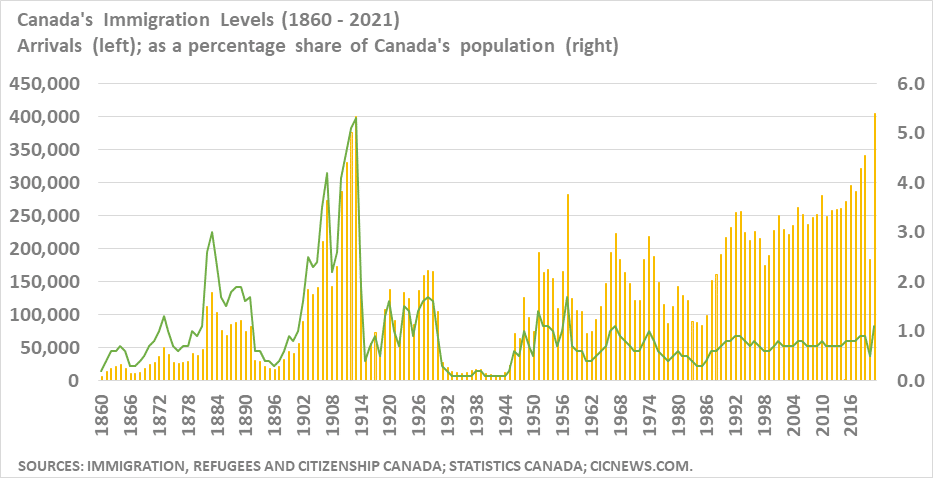Canada increases target to 432,000 immigrants in 2022 under Immigration Levels Plan 2022-2024
The Canadian government has just announced its Immigration Levels Plan 2022-2024.
Canada is increasing its immigration targets yet again. It will look to welcome almost 432,000 new immigrants this year instead of its initial plan to welcome 411,000 newcomers.
The announcement came today at approximately 3:35 p.m. Eastern Standard Time.
Get a Free Canadian Immigration Evaluation
Over the coming three years, Canada will target the following number of new immigrant landings:
- 2022: 431,645 permanent residents
- 2023: 447,055 permanent residents
- 2024: 451,000 permanent residents
In a statement to CIC News, Immigration Minister Sean Fraser explained "This levels plan is a balance of needs for our country and our international obligations. It focuses on attracting skilled workers who will contribute to Canada’s economy and tackle the labour shortage, while recognizing the importance of family reunification, and helping the world’s most vulnerable populations through refugee resettlement. Our focus remains on supporting our economic resurgence through increased retention of newcomers in regions with real economic, labour and demographic challenges. I’m proud of what Canada has achieved thus far, and I want wait to see how newcomers will continue to make Canada a top destination of choice.”
In 2022, some 56 per cent of new immigrants will arrive under economic class pathways such as Express Entry, the Provincial Nominee Program (PNP), and the Temporary to Permanent Residence (TR2PR) stream that was available in 2021.
The PNP will be the main admissions program for economic class immigrants with Immigration, Refugees and Citizenship Canada (IRCC) looking to land 83,500 newcomers via the PNP in 2022. IRCC has cut Express Entry admissions in half for this year but aims to return to normal Express Entry admissions levels by 2024 when it targets the arrival of 111,500 Express Entry immigrants then.
The levels plan seems to suggest that IRCC is temporarily reducing Express Entry admissions so it can accommodate admissions under the TR2PR program. IRCC is looking to land 40,000 immigrants in 2022 and the final 32,000 immigrants by 2023 under the TR2PR stream.
In the meantime, Express Entry draws are continuing on a biweekly basis and IRCC is processing Express Entry applications.
In addition, most of Canada's provinces and territories operate the PNP and PNP invitations have been ongoing since the start of the pandemic.
The family class will comprise 24 per cent of admissions targets in 2022, with 80,000 set to arrive under the Spouses, Partners, and Children Program, and 25,000 set to arrive under the Parents and Grandparents Program (PGP). IRCC has increased its PGP admissions target slightly, by 1,500 additional spots, compared with its previous plan.
The remaining 20 per cent of immigrants will arrive under refugee and humanitarian programs. This is an increase of about 5 percentage points compared to Canada's last immigration levels plan, and it is likely a function of Canada looking to resettle 40,000 Afghan refugees over the coming years. The higher refugee and humanitarian intake will result in economic and family class immigration comprising a smaller share than usual, however both those classes will account for a higher share of Canada's newcomers in 2023 and 2024, as Canada looks to reduce its refugee and humanitarian intake once it completes its Afghan resettlement operation.
| Immigration Class | 2022 | 2023 | 2024 |
|---|---|---|---|
| Economic | 241,850 | 253,000 | 267,750 |
| Family | 105,000 | 109,500 | 113,000 |
| Refugee | 76,545 | 74,055 | 62,500 |
| Humanitarian | 8,250 | 10,500 | 7,750 |
| Total | 431,645 | 447,055 | 451,000 |
Today's announcement was the first Immigration Levels Plan since October 2020.
Canada's main immigration law, the Immigration and Refugee Protection Act (IRPA), states the Canadian government must announce its immigration plan by November 1 each year when Parliament is sitting. However, a levels plan announcement did not take place last year due to the Canadian government holding an election in September.
The levels plan guides Canada's immigration system. It outlines the number of immigrants Canada will look to welcome under its various federal, provincial, and territorial programs. IRCC and the provinces and territories then adjust their operations based on the plan to ensure they are able to attract, settle, integrate, and retain the targeted levels of newcomers set to arrive.
Get a Free Canadian Immigration Evaluation
Up until 2015, Canada welcomed about 250,000 immigrants per year. In 2016, it announced a new baseline target of 300,000 newcomers annually. Prior to the pandemic, the target was set to about 340,000 immigrants per year but immigration fell to below 200,000 in 2020 due to the pandemic.
The Canadian government then made the surprise announcement in October 2020 it would look to welcome over 400,000 immigrants annually moving forward to help support its post-COVID economic recovery. This represents the highest targets in Canadian history.
Last year Canada broke its newcomer record by landing 405,000 new permanent residents, mostly by transitioning those within the country to permanent residence. Prior to the pandemic, most new immigrants arrived to Canada from abroad.
In 2021, 62 per cent of new immigrants arrived under economic class pathways such as Express Entry, the PNP, and Quebec's streams.
Some 20 per cent were welcomed last year under the family class through the Spouses, Partners, and Children Program and the Parents and Grandparents Program.
A total of 15 per cent were welcomed in 2021 under refugee and humanitarian programs.
The remaining amount were categorized under "All Other Immigration."
Canada targets high levels of newcomers to support its economy and fiscal standing. Due to its aging population and low birth rate, Canada needs higher levels of immigration to support its population, labour force, and economic growth, as well as to have enough workers to pay the taxes necessary to support important social services such as health care and education. Canada also pursues social immigration objectives including reuniting families, providing humanitarian assistance, and strengthening its Francophone heritage.
Immigration has arguably taken on greater economic importance during the pandemic. Governments across Canada are running fiscal deficits due to increased spending amid the pandemic and weaker economic activity. In addition, employers across Canada are facing labour shortages due to Canada's aging population, major changes to the economy during COVID, and fewer immigrants arriving from overseas.
Need Help with Canadian Work Permits? Contact Cohen Immigration Law for a Free Consultation

Immigration Levels Plan 2023-2025 to be announced by November 1st, 2022
Barring the very unlikely scenario Canada holds an election for the second year in a row, the Canadian government will be legally required to table its second Immigration Levels Plan of the year by Tuesday November 1st, 2022 at the latest. This plan will replace the one announced today.
As noted, the 2021 announcement did not take place due to the September federal election.
The Immigration Levels Plan 2023-2025 will be the normally scheduled announcement.
Need Help with Canadian Work Permits? Contact Cohen Immigration Law for a Free Consultation
© CIC News All Rights Reserved. Visit CanadaVisa.com to discover your Canadian immigration options.
- Do you need Canadian immigration assistance? Contact the Contact Cohen Immigration Law firm by completing our form
- Send us your feedback or your non-legal assistance questions by emailing us at media@canadavisa.com







